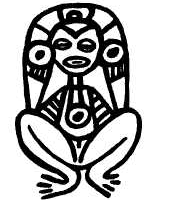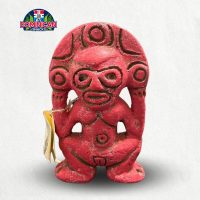Atabey : The Taíno Mother of Waters and Creation
Listen
At a glance
| Description | |
|---|---|
| Origin | Taino Mythology |
| Classification | Gods |
| Family Members | Yúcahu, Guacar (Sons), |
| Region | Puerto Rico, Dominican Republic, Haiti, Cuba, Jamaica, and the Bahamas |
| Associated With | Fertility, Birth, Sea |
Atabey
Introduction
Atabey is one of the most significant deities in Taíno mythology, revered as the Mother of Waters, the primordial source of creation, and the ancestral spirit who governs fertility, childbirth, and the life-sustaining rhythms of nature. Recognized across the Greater Antilles—including Puerto Rico (Borikén), Hispaniola, Jamaica, and Cuba—Atabey is not merely a goddess but a zemi, a powerful embodiment of natural and cosmic forces. She represents the origin of freshwater, the movement of tides, the fertility of soil, and the generative principle that sustains both human life and the wider environment. For the Taíno, Atabey’s presence affirmed the sacred nature of their lands and waters, and today she remains a potent cultural symbol of identity, ecological balance, and Indigenous resurgence.
Physical Traits
Taíno iconography consistently portrays Atabey as a figure tied deeply to fertility and creation. She is most famously depicted in a squatting birthing posture found in ancient petroglyphs and stone carvings—knees raised, hands on legs, and head tilted upward—capturing the moment of life emerging from the cosmic mother. In other representations, her form is human with pronounced feminine features, stressing her association with maternity and abundance.
Some zemí sculptures present Atabey with hybrid or animalistic elements, reflecting her ability to move between natural and spiritual realms. These therianthropic depictions emphasize not only her dominion over water and fertility but also her role as a guardian of the forests, mountains, and rivers. Whether serene or imposing, her form conveys an intimate relationship with the cycles of creation, renewal, and natural order.
Family
In Taíno cosmology, Atabey’s family shapes the structure of the world. She is the mother of Yúcahu, the principal agricultural deity responsible for cassava, the staple food of the Taíno. His birth from Atabey signifies the earth’s capacity to nourish the people, binding her maternal essence to everyday survival. Another son, sometimes called Guacar or Guacaracar, appears in myth as a being connected to jealousy and imbalance, representing the tensions inherent in creation.
Some myths also reference Yaya, a primordial being associated with Atabey, and their child Yayael. This narrative thread, found in various colonial-era accounts, describes Yayael’s death and eventual transformation into the sea, linking Atabey’s lineage directly to the origins of the ocean. Through these family relationships, Atabey stands at the core of cosmic birth, agricultural continuity, and the spiritual ancestry of the Taíno people.
Other names
Across different Taíno communities and over centuries of oral retellings, Atabey has been known by several names that emphasize her distinct aspects. Atabeyra and Atabex highlight her connection to water and cyclic movement. Caguana refers to her nurturing and protective aspect, particularly in relation to love, harmony, and ceremonial dances. Her fierce, storm-bearing manifestation—Guabancex—represents the raw, destructive forces of nature such as hurricanes (juracanes), turbulent winds, and earth-shaking upheavals. These variations reveal the Taíno understanding of a deity who embodies both benevolence and ferocity, reflecting the dual nature of the Caribbean environment itself.
Powers and Abilities
Atabey’s powers extend across the essential systems of life and nature. As the Mother of Waters, she governs lakes, springs, rivers, and the sea’s tidal movements. Because fresh water was vital for agriculture, sustenance, and spiritual purification, her influence was invoked for rains, fertile soil, and protection from drought. As the ultimate maternal force, Atabey presides over fertility and childbirth, ensuring the continuity of families and communities. Women prayed to her for safe deliveries and guidance throughout pregnancy, reinforcing her role as a compassionate guardian of life.
Her lunar association connects her to tides, menstrual cycles, and the passage of time, placing her within celestial rhythms that governed both agriculture and spiritual ceremonies. In her storm aspect, Atabey manifests as Guabancex, the force behind hurricanes and elemental disruption. Rather than a malevolent role, this aspect expresses the natural cycle of destruction and renewal, a reminder of nature’s power to cleanse and rebalance. Through these combined powers—creation, fertility, water, moon, and storm—Atabey embodies a complete cosmic force essential to the Taíno worldview.
Modern Day Influence
Atabey continues to hold profound meaning across the Caribbean and within Taíno revival movements. For many Puerto Rican and Dominican communities, she symbolizes Indigenous identity, resilience, and reconnection to ancestral roots. Modern Taíno organizations honor Atabey in ceremonies that celebrate water, women, and the renewal of cultural memory. Her imagery appears in murals, carvings, jewelry, and tattoos, signifying pride in Indigenous heritage.
Environmental groups have adopted Atabey as an emblem of ecological stewardship, particularly in campaigns focused on river protection, forest preservation, and sustainable living. Artists and writers frequently reimagine her in contemporary forms, blending traditional Taíno mythology with modern themes of feminism, land rights, climate awareness, and Caribbean spirituality.
In academia, Atabey’s significance has grown as scholars challenge outdated colonial narratives that claimed Taíno culture disappeared. Instead, Atabey stands today as a testament to the endurance of Taíno identity and the ongoing evolution of Indigenous thought. Whether in cultural festivals, schools, community rituals, or global Indigenous discourse, Atabey continues to inspire a renewed appreciation for the sacred connection between humanity, water, and the living earth.
Related Images
Source
Wikipedia contributors. (2012, February 8). Atabey (goddess). Wikipedia. https://en.wikipedia.org/wiki/Atabey_(goddess)
Granberry, J., & Vescelius, G. (2004). Languages of the Pre-Columbian Antilles (Vol. 1). University of Alabama Press.
Wilson, S. M. (1990). The Indigenous People of the Caribbean. University Press of Florida.
Rouse, I. (1992). The Tainos: Rise and Decline of the People Who Greeted Columbus. Yale University Press.
González, C. M. (2018). Abuelas, ancestors and Atabey: The spirit of Taíno resurgence. American Indian Magazine, 19(3). https://www.americanindianmagazine.org/story/abuelas-ancestors-and-atabey-spirit-taino-resurgence
Stevens-Arroyo, A. M. (1993). Cave of the Jagua: The Mythological World of the Taíno. University of New Mexico Press.
Oliver, J. R. (2009). Caciques and Cemí Idols: The Web Spun by Taíno Rulers Between Hispaniola and Puerto Rico. University of Alabama Press.
Pagan-Jiménez, J. R. (2011). Taíno spirituality and the sacred landscape. Caribbean Quarterly, 57(2), 45–66.
Vega, B. (1979). Los Taínos. Museo del Hombre Dominicano.
Arrom, J. J. (2000). Mitología y artes prehispánicas de las Antillas. Fondo de Cultura Económica.
Frequently Asked Questions
Who is Atabey in Taíno mythology?
Atabey is the Taíno Mother of Waters, goddess of fertility, freshwater, and creation, and one of the most important deities in Caribbean Indigenous mythology.
What powers does Atabey have?
She controls freshwater, fertility, childbirth, lunar cycles, tides, and—in her fierce aspect as Guabancex—the forces of hurricanes and natural upheaval.
Is Atabey the same as Guabancex?
Guabancex represents one of Atabey’s storm aspects, emphasizing destruction and renewal, rather than a separate goddess in many interpretations.
Why is Atabey important today?
She symbolizes Indigenous revival, environmental guardianship, feminine strength, and the enduring resilience of Taíno culture.
What does Atabey look like in Taíno art?
She is often depicted in a birthing posture or as a feminine figure tied to water, fertility, and the natural world, based on petroglyphs and zemí carvings.








